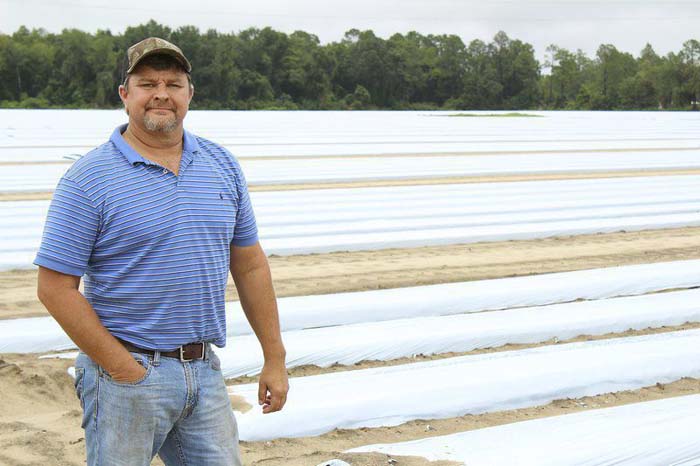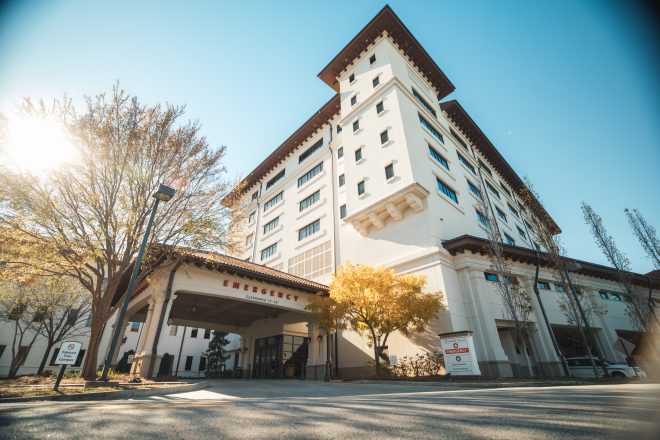Southern Grown: Technology brings changes to agriculture industry
Published 10:00 am Thursday, August 9, 2018

- Brian Corbett, co-owner of Ty-Core Farms, said not a lot has changed in the farming business in the last 15 years.
Editor’s note: This is the second part of a two-part look into agribusiness in our region. For part one, please see the Sunday, Aug. 5 edition of The Tifton Gazette
TIFTON — There have been a lot of changes to the agriculture industry, mostly in the realm of technology.
Trending
Technology both helps the farmer increase yield but is also expensive. In many cases technology cannot take the place of human labor, but the cost of that labor and the rules that regulate it sometimes make things difficult.
Events that play out on the international stage have a direct impact on agribusiness on the local level.
TECHNOLOGY
The largest change in the industry is in technology.
Large-scale operations are using state-of-the-art equipment and innovative practices as well as diversifying to stay ahead of the game and continually increase yield while keeping overhead down.
Justin Hand, Tift County agriculture and natural resources extension agent, said that changes in technology has been the single biggest change in agriculture as an industry.
Trending
“As far as technology goes, you’re looking at anything from legit computer tech in the tractors to chemicals to having apps on their phones to turn pivots on from across town,” he said. “All you need is a wifi signal. It’s coming along, and it’s big business, too. It’s not just the plows and the cotton and the old beat-up tractors anymore. It’s a legit industry. It affects so much.”
This includes both changes in farming practices, such as when and how often to spray pesticides and fungicides, to creating Round-Up resistant strains of cotton and using tech such as iPads and drones to automate processes.
“We have a lot of progressive farmers in Tift County,” he said. “We’ve got a couple that are like, ‘Well grandpa always did it this way,’ but we actually have a lot of progressive farmers that are really on the cutting edge.”
Technology utilization makes the difference, he said. Some outfits have precision planting equipment and their irrigation systems will have water probes throughout the field, so it will gauge when to water and where to water, which also helps with water conservation.
Hand said technology gives them an edge compared to those who aren’t utilizing it. “At the end of the day when they go and pull yield on them, those guys are always going to be higher,” Hand said. “More input obviously, but they’ll have a higher, better crop nine times out of 10.”
Hand said another example of being on the cutting edge is a resource he calls “peanut RX.”
It is a survey that helps farmers know when in the growth cycle to spray their peanuts, what to watch out for and how often to spray, based on records of peanuts grown in that field or area.
“I go back to mule days, when I was a boy,” said Louie Perry, a Colquitt County farmer, who was born in 1939. “I was there when the first tractor came to the farm.”
“The ’50s is when they got to going pretty strong,” Perry said of tractors and other machinery. “When I went to college we had three tractors, all 50 horsepower or less.”
In the early days of tractors, the cost could be as little as $400 — still a lot of money in the early 1900s. Today, a 115-horsepower John Deere can start in the range of $100,000 and a huge cotton picker can fetch $700,000.
The larger farms that have emerged need bigger machines. In addition to getting bigger, just like most people’s phones, tractors are getting smarter.
Huge irrigation pivots powered by electricity or natural gas water huge fields of row crops; drip irrigation is used on vegetables.
Using GPS technology, for instance, farmers can plow in the spring — with the tractor steering itself through the field and being turned around by the operator at the end of the row. Then at harvest time, the tractor can drive itself in the exact same path, increasing the amount of cotton picked.
But Brian Corbett, co-owner of Ty-Core Farms in Lowndes County, said not a lot has changed in the farming business in the last 15 years.
As far as picking technology goes, it’s pretty much the same, but packaging and marketing is becoming a much bigger issue, he said.
“We’re getting orders where we have to put stickers on every pepper,” Corbett said. “So we have to buy equipment that will apply the stuff to it and other things like that.”
Corbett grew up in farming. His dad started growing tobacco until the tobacco companies bought his farm in the early 2000s, Corbett said. Now, he grows and sells fresh vegetables all over the eastern United States. Ty-Core Farms sells about 1.2 million packages a year to cities mostly along the East Coast.
Its number one cash crop is bell peppers, but it also grows about seven different kinds of crops, including eggplants, cabbage and zucchini.
Global positioning system planting is a new trend in agriculture.
“A lot of people are going to the precision farming to try to save money, cut costs, make it more economical,” said Ken Hickey, a Thomas County farmer.
GPS is set on a tractor, the operator releases the steering wheel, and the GPS decides the row for planting and guides the tractor to the end of the row, where the operator turns the tractor around. The GPS method is repeated on the next row.
GPS also is used to fertilize, spray and gather crops.
“If you sit still and never do anything, you’ll never get ahead,” said Hickey, a longtime Thomas County commissioner.
Jessica Brim Kirk, director of food safety and marketing at Lewis Taylor Farms in Tift County, said the farm uses drones to look at the overall slope of the land and help with planning out what crop to plant where, as well as working with researchers to implement cutting-edge practices in the field.
“We do a lot of work hand in hand with the University of Georgia and extension,” she said. “It’s a win-win for everybody. They learn something, we learn something in turn and it’s a more hands-on learning experience for the kids.”
Kirk said things have changed in the industry even since she was a little girl, growing up on the farm.
“Everything’s done by GPS,” she said. “It’s not done by hand anymore. There’s so many different crops. We grow both organics and conventional vegetables now.”
She said that one issue that she sees is a lot of misinformation concerning agriculture.
“People aren’t educated about what stuff is, what it means and why it’s done one way or another,” she said.
She gave genetically modified organisms as an example. Many people have a problem with GMOs because they think they are something like a franken-food, cooked up in a lab that will harm people who consume it.
“Most of your consumables, although they may have created a genetically modified version of it, they’re not on the market,” she said. “Most people don’t realize that. You can’t go to the store and buy GMO squash, it doesn’t exist. They have it in cotton and in corn, but it’s for feed corn for livestock, not for people to eat.”
She said humans have been modifying things they eat since they began cultivating crops during the early days of human civilization.
“I ask people if they eat broccoli,” Kirk said. “They always say yes, and I tell them they’re eating a GMO because years and years and years ago broccoli was modified from what it was, not using our current technology but using the technology they had at the time to create broccoli as we know it.”
Kirk refers to other results of modifying foods through selective breeding, such as mangos and wheat, adding there is no scientific proof these plants have harmed anyone.
Kirk said organic foods have misinformation swirling around them. She said organics are still sprayed with pesticides, but spraying organics is very unregulated, whereas conventional crops are highly regulated.
“They can spray as much as they want,” she said, referring to organics. “There’s no limits on how much they can spray. So honestly, you’re probably getting more pesticides on an organic than you are on a conventional.”
Kirk said she started a Facebook page and an Instagram account to combat the misinformation and help educate people. The use of social media for promotion and education is yet another way agriculture and technology are becoming intwined.
LABOR AND
REGULATION
Hand said local governments seem to be supportive of agriculture in their communities.
“They don’t get in the way,” he said, but the federal government can get in the way, sometimes. “I think it’s better than it had been, from what I can gather from everyone.”
He said farmers growing cotton and soybeans are worried about China, but most farmers are focusing on the North American Fair Trade Agreement.
“I think all the farmers like free trade because it helps them easily get their products around to different places,” Hand said. “But for example, there were several hundred loads of produce dumped in California last week, and obviously that’s going to drop our prices here because we’re a big vegetable county. So we’ve actually had a few farmers have to leave product in the field because they couldn’t afford to pick it this year because of a big produce dump from Mexico.”
Hand gave cucumbers as an example, saying Mexico is selling cucumbers for $7 a box and Georgia cucumbers cost $9 a box before it even leaves the packing shed.
Farms that left product in the field allowed people to come in and pick what they wanted and donated a lot of that product to food banks, too.
“They try to give out as much as they can,” Hand said. “They don’t like to see it just rot.”
Selling fresh vegetables, instead of row crops such as corn, means crops have to be picked by hand.
So, labor is one of their biggest issues, Kirk said.
Kirk said the company makes sure its employees are H2A employees, which is a visa program that brings in seasonal workers from other countries to work the farms.
“We bring them in from Mexico and El Salvador,” she said. “They can come in and we guarantee them a certain pay rate which is well above minimum wage. We provide housing for them, transportation, health care. At our cost, not their cost.”
With the wage they’re paid, the added cost of everything they provide, the cost per person, per hour is approximately $15 per hour, Kirk said.
She said it’s a really big issue because of the need for that labor and the expense of it.
“It’s really expensive and we don’t have a choice,” Kirk said. “We see it as something that we have to do to protect ourselves, first to make sure we have a viable work force.”
She said the farm doesn’t hire anyone without legal status because the risk isn’t worth it.
“We mostly use migrant workers who come here from Mexico,” Corbett said of Ty-Core Farms. “We bring in around 200 to 250 people a year, and the government has some substantial laws regulating what a person has to have for suitable living space.”
Some of the regulations can be very specific, Corbett said. For example, the farm was written up once when a worker left eggs outside of a refrigerator.
“It’s dumb laws like that,” he said.
Most laws and regulations he would like to change come from the federal level. He said farming is impacted by every new president, and President Donald Trump has made things easier than when President Barak Obama was in office.
“With the last eight years, while Obama was in office, it was pretty much all we could do to just keep our head above water,” Corbett said. “It’s changed since Trump has gone into office and started shaking things up a little bit.”
He said Trump is more critical on trade agreements with other countries such as Mexico that have fewer regulations. Corbett said he can’t compete with countries that pay their workers $6 a day when he has to pay his workers $10 an hour. He also has to follow strict regulations about food safety, while other farmers have no one watching over them.
“There’s no one making sure they aren’t using the wrong chemicals or something like that,” Corbett said. “They just send truck after truck in here without any checks and balances.”
Farming in the Lowndes County and Echols County area comes with its benefits, he said. The farm is never short on water, and farmers in the area get along with each other pretty well, he said.
“This is a very good place for what we do,” Corbett said. “In a lot of places around the country they have water restrictions. We don’t have that here. And everyone around here is pretty friendly. When prices get low, it can get a little cutthroat, but the majority of it is friendly.”
As far as the future of farming, Corbett said he looks forward to the rise of new technology in farming. He said he knows there is research going into making machines that can pick fresh vegetables, which Corbett would be interested in.
However, a machine capable of doing what a person can do would take an array of censors and robotics that technology can’t do right now, he said.
Until technology catches up with humans, Corbett asked that people set aside their biases against migrant workers who come to the U.S. just looking to do the work no one else wants. He said he would also like for laws to treat workers more fairly while they are here.
“One of the things that bothers me most is the ignorance of the importance of migrant workers,” Corbett said. “If we want our food picked, it has to be done with their help. The law snatches them up left and right and sends them back home, and they’re just here working and gathering our food for us.”
The SunLight Project team of journalists who contributed to this report includes Thomas Lynn, Derrek Vaughn, Jason Smith, Kevin Hall, Patti Dozier, Will Woolever, Eve Copeland and Jessie Box.





